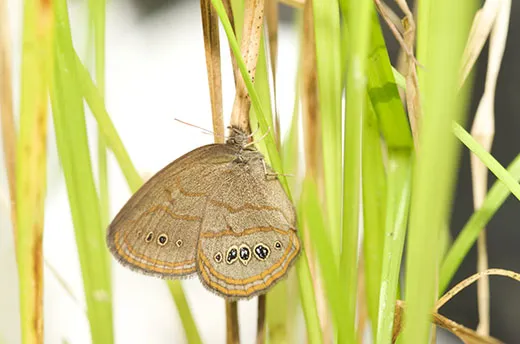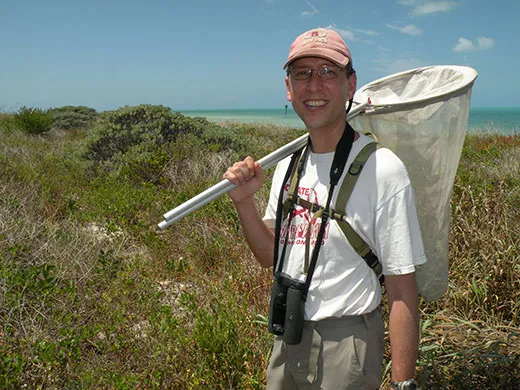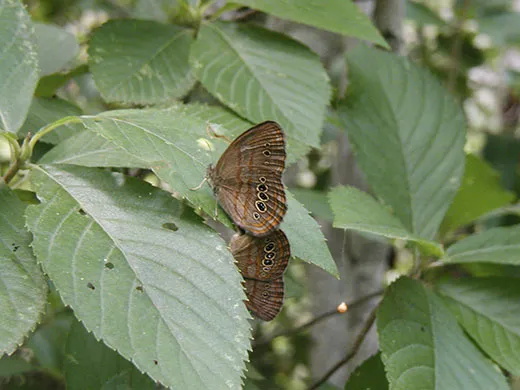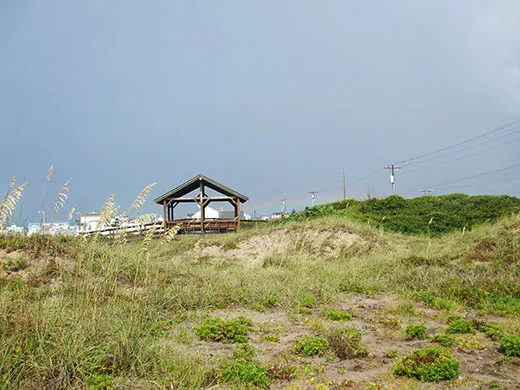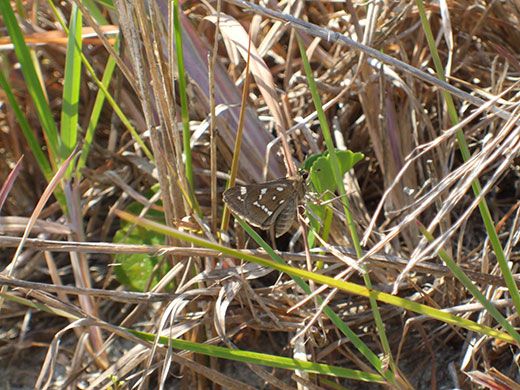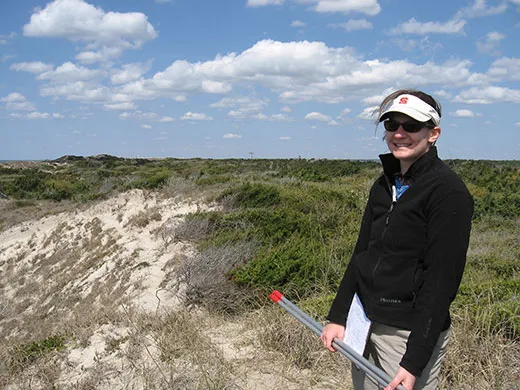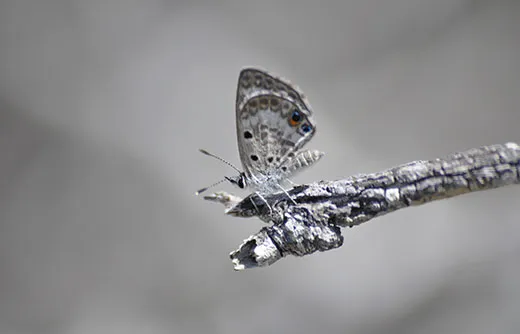Who Can Identify the World’s Rarest Butterfly
Two scientists are in a grim contest to document some of the animal kingdom’s most endangered species
/https://tf-cmsv2-smithsonianmag-media.s3.amazonaws.com/filer/Butterflies-631.jpg)
Nick Haddad is a tall, quick-to-smile Minnesotan. But lest the easy grin fool you, he is also a man who likes to win. He wins in Scrabble. He tries to win in basketball. And he thinks he has won in the grim contest waged among biologists over which is the rarest butterfly in the world.
Haddad spends hundreds of hours a year studying the St. Francis Satyr, a small brown butterfly the size and weight of a folded postage stamp. The St. Francis Satyr lives at Fort Bragg, a military base near Fayetteville, North Carolina, and nowhere else. The St. Francis Satyr was once common but is now on the brink of extinction.
One part of the story of the St. Francis Satyr begins with beavers. If you’ve ever wondered just how whimsical evolution can be, consider beavers. They are the answer to that question and the punchline. They are giant rodents with ping-pong paddle tails. They live in houses they build of sticks. They dam rivers to make ponds and have teeth that will grow through their heads if not constantly worn down through use. Unfortunately, much of what makes beavers interesting also puts them at odds with humans. They impede the flow of rivers. They cut down trees. And they have thick, dense fur, perfect for a cape or coat. Consequently, the North American beaver, an animal that once may have numbered close to 90 million, is now rare in many regions and extinct in others. In much of the southeastern United States, including North Carolina, the beaver was gone by the turn of the last century.
The beaver’s story matters to butterflies because when beavers disappear, so do dams. Dams lead to ponds that eventually lead to meadows that sprout sweet young sedges, into which the St. Francis Satyr’s larvae sink their mouthparts one bite at a time.
When the beaver became rare, it appears the St. Francis Satyr did, too. Satyrs now number around 1,000 and are found in an area of less than 20 acres. The butterfly was discovered in 1983 by a collector named Thomas Kral. He named it in honor of St. Francis, the man who spoke to and, more importantly, listened to animals. Kral was convicted of conspiracy to violate the wildlife laws of the United States (though not the St. Francis Satyr, which was not yet listed as endangered or even known to exist when he collected 50 individuals). The Satyr persists both because of and in spite of the man who named it. It also persists because of war, or preparations for it.
In the United States, many plant and animal species, including the St. Francis Satyr, have benefited from military bases, where they tend to be relatively well protected from habitat loss. Despite the sounds of guns and bombs, the species are preserved. But the case of the St. Francis Satyr is a special one. The St. Francis Satyr may have survived because of bombs. At Fort Bragg, weapons—from big bombs to small bullets—are used nearly every day in soldiers’ training. The explosions start fires that burn the forests and allow sedges to grow on meadows, and with them, here and there, a few butterflies. Once the entire southeastern United States, from Florida to Raleigh, burned every few years naturally. Now Fort Bragg is one of the few places where the wilderness and its necessary flames remain.
So far bombs and the slow recovery of beavers, which are multiplying in the absence of hunting on the base, have saved the St. Francis Satyr at Fort Bragg, but just barely. Without more bombing (or other forms of burning) and beavers, meadows would grow over, bombed areas would grow back and the butterfly would have nowhere to go. Fortunately, this butterfly has advocates. St. Francis spoke on behalf of all animals. Nick Haddad speaks on behalf of just one, the St. Francis Satyr. He speaks on its behalf all the time, and when he does he tends to remind his audience that he is studying “the rarest butterfly in the world,” a statement that received little argument in the Southeast until Allison Leidner came to town and Haddad got competitive.
Allison Leidner is an unlikely character in the story of rare butterflies. Now a fellow at NASA in Washington, D.C., Leidner is a New Yorker with a fondness for city life who wanted to save species, to lift them up from the brink the way you might pick up a wounded bird. She came to North Carolina to study with Nick Haddad, and that was when the trouble started.
Not long after Leidner arrived in North Carolina, she heard about another rare butterfly, rumored to live on just a few islands of the Outer Banks. Allison decided to look for it and found it: it was lovely and rare, very rare. It did not yet have a scientific name. It still doesn’t. It is called, simply, “Atrytonopsis new species 1” or, as she dubbed it, the Crystal Skipper, an unnoted gem skipping among the dunes.
Anyone could see a Crystal Skipper if they wanted to. Many rare species live in hard-to-reach places, such as bombing ranges, but not the Crystal Skipper. It can be found in backyards on the islands. The tiny larvae of the Crystal Skipper crawl along grass leaves waiting to metamorphose, or on sand dunes or in a patch of grass behind the Food Lion. But wherever they are, the caterpillars often represent the entirety of their species. Most of the year no adults are flying through the air. No eggs wait to open. These larvae are it, the sum living total of what Leidner now thinks may be the rarest butterfly species in the world—or if not the rarest, the most precarious, perched as it is on the dunes between the rising sea and the encroaching city.
The good news about the Crystal Skipper is that it seems to do relatively well with urbanization. Like Leidner, the species is simultaneously urban and in love with a few dear and wild things, in its case a host plant, the little bluestem, a type of beach grass. The Crystal Skipper flies easily among the beach houses that rise up out of the sand in long, colorful rows. The houses themselves may be reconcilable with the conservation of the Skipper, as long as the little bluestem survives. The trouble is that houses do not arrive alone. With them come roads, grocery stores and lawns that tend to replace the wild, unkempt beach grass on which the Skipper depends. As far as anyone knows, the Crystal Skipper feeds on nothing else but little bluestem and lives nowhere else other than on the sandy patches of a few small islands. It is both rare and dependent, the last tenuous piece on a whirring mobile of coastal life.
Part of the rarity of the Crystal Skipper may be natural, a consequence of where it lives. Off and on over the past few millions years, the patches of dunes on the Outer Banks have been separated both from each other and from the mainland. Plants and animals that have persisted on or colonized the islands have become separate, too, and evolved into different species. This appears to be the case for the Crystal Skipper, whose closest likely relatives live in Florida, among the snowbirds. Because its story began with isolation on small islands, the Crystal Skipper was never common, but it is probably more rare than it has been for thousands of years. Leidner thinks, for example, that it used to live on the Shackleford Banks, where wild, hungry horses now roam and eat nearly everything, including the little bluestem, down to the ground. As they do, they also consume any chance for the Skipper to persist. On other islands, houses and civilization have replaced many acres of dunes and wild grass. What the Crystal Skipper has to work with now is just a small vestige of an already small wild past.
And so there are two rare butterflies in North Carolina, each with its own champion. Both Haddad and Leidner would be proud to be the one studying the world’s rarest butterfly, the rarer of these two. Haddad is still sure he has won. Leidner equivocates. “Depends on the year,” she says. But the bigger win would be to lose: The more rare either butterfly is, the more likely it will go extinct, whether because of the actions of humans, or now that humans have pushed these species to the edge, because of chance. And so they try, through talks about what needs to be done, through restoration projects and through whatever else they can do, to make the species they work on more common.
In the meantime, Haddad has not yet told Leidner, but he has begun working on what might be an even rarer species, the Miami Blue, which lives in the Florida Keys and numbers at most in the tens. Others may, in this case, agree that this butterfly is the rarest. The Miami Blue has recently been emergency listed as an endangered species, which will afford it some protection from additional threats posed by humans, out on the tiny islands in the enormous sea. Nick thinks it’s the winner, at least for now, though there are so many rare species flickering on the verge of extinction that it is impossible to know for sure.
Just outside San Francisco, the Lange’s Metalmark butterfly struggles to survive on a few old desert dunes. Another kind of butterfly, El Segundo Blue, lives only on the sand at the end of the runway at Los Angeles International Airport. Still another, the Uncompahgre Fritillary, is found only in small patches of habitat above 13,000 feet in Colorado’s San Juan Mountains. Then there are still others, outside the United States, although less data is available for them. Rare species persist, for now, in many places where someone has looked carefully. Some of those species have defenders like Haddad or Leidner. Most, particularly those in places like the tropics where fewer biologists are around to take stock, do not. They simply live and die, influenced by our actions but unnoticed as they rise up on the wind or fail to. Sometimes it is said that a butterfly flapping its wings in Japan can change the weather in Raleigh. Maybe. It seems more likely that a conservation biologist waving his or her hands can change the fate of a butterfly, or at least that is what we might hope: that in the battle over the rarest species, biologists all around the world begin to lose.
Editor's Note, November 9, 2011: We apologize for an error in the original version of this story. Thomas Kral was convicted of violating the wildlife laws of the United States and sentenced to community service, fined and placed on probation, but not jailed.
| The very rarest butterflies | |
| Lotis blue | Lycaeides argyrognomon lotis |
| Miami blue butterfly | Cyclargus thomasi bethunebakeri |
| Saint Francis' satyr | Neonympha mitchellii francisci |
| Schaus swallowtail | Heraclides aristodemus ponceanus |
| Lange's metalmark | Apodemia mormo langei |
| Palos Verdes blue | Glaucopsyche lygdamus palosverdesensis |
| Leona’s little blue butterfly | Philotiella leona |
| Island Marble | Euchloe ausonides insulanus |
| Also very, very rare | |
| Mt. Charleston blue | Icariacia shasta charlestonensis |
| El Segundo blue | Euphilotes battoides allyni |
| Crystal skipper | Atrytonopsis new Sp.1 |
| Mitchell's satyr | Neonympha mitchellii mitchellii |
| Laguna Mountains | Pyrgus ruralis lagunae |
| Behren's silverspot | Speyeria zerene behrensii |
| Also rare | |
| Fender's blue | Icaricia icarioides fenderi |
| Carson wandering | Pseudocopaeodes eunus obscurus |
| Callippe silverspot | Speyeria callippe callippe |
| Mission blue | Icaricia icarioides missionensis |
| San Bruno elfin | allophrys mossii bayensis |
| Myrtle's silverspot | Speyeria zerene myrtleae |
| Quino checkerspot | Euphydryas editha quino (=E. e. wrighti) |
| Smith's blue | Euphilotes enoptes smithi |
| Uncompahgre fritillary | Boloria acrocnema |
| Karner blue | Lycaeides melissa samuelis |
Rob Dunn is a writer and biologist at North Carolina State University. His latest book is The Wild Life of Our Bodies. He has written about the deadliest animals in humans’ evolutionary past, singing mice, rudeness, the discovery of the hamster, and many other subjects for Smithsonian.

